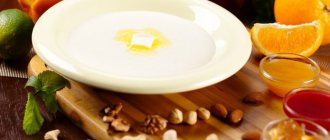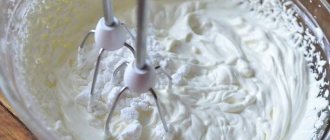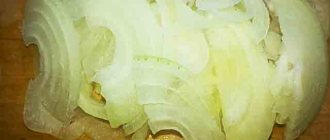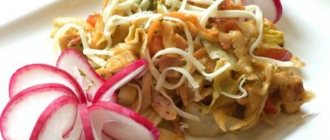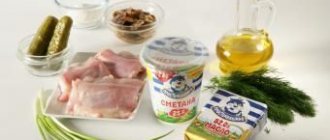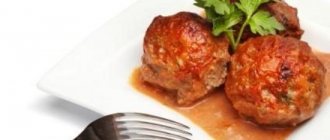The passion for exotic, particularly oriental, cuisine has recently outgrown the love for sushi alone and reached a new level. Now not only restaurants offer more complex and unusual dishes, but also advanced housewives are willing to try new products in their home kitchens. Cooking seafood, storing vegetables and multi-stage processing are already a completed stage for many of them. But the mysterious word “funchose” and the original appearance of these Asian noodles still raise eyebrows. And if so, then it’s time to learn more about it and the rules for its use.
What is funchose
Funchoza is a traditional dish in Japan, China and Korea, as well as the raw material for its preparation. More often than this name, which is unusual for the Slavic ear, the phrases “glass noodles”, “rice noodles” and simply “Chinese noodles” are used to designate it. Essentially, this conveys both the composition and appearance of this product. In dry form, funchose looks like a ball of thin whitish fibers tightly intertwined with honey, round in cross-section, more or less thin in diameter. When cooked, they become translucent and/or acquire the color of a sauce.
It is this property - the ability to absorb any aromas and tastes of other products - that makes funchose a universal base for salads, soups, hot dishes and cold appetizers. Glass noodles do not have their own taste, but when boiled, stewed, or deep-fried, they become a light, nutritious and tasty addition to meat, fish, vegetables and mushrooms. Most often it is served with pickled peppers, onions and ginger as part of warm salads, traditional for Asian cuisines.
Classic Chinese noodles made from rice flour resemble milky white Italian spaghetti when cooked. More consistent with the name “glass” are noodles prepared on the basis of starch: bean, potato, yam or cheaper and more profitable for industrial production corn. Starch funchose is more elastic, and its fibers do not boil, maintaining their shape and structure. According to legend, it became the prototype of modern pasta after it was brought to Italy in the luggage of the traveler Marco Polo.
Preparation of funchose
As you can see, funchose is somewhat different from other pasta, and therefore the rules for its preparation also have their own nuances. It is sold dried and usually inside the package it consists of long noodles woven into oblong balls. Before consumption and adding to other ingredients, funchose is boiled or boiled in one of the following ways:
- Place dry noodles in a deep bowl or salad bowl and pour boiling water so that the water completely covers the fibers, cover with a lid. After 3-4 minutes, drain the water, and use the steamed noodles for further preparation as part of complex dishes or serve as a side dish. This method of brewing funchose is not suitable for all varieties, but only for the thinnest glass noodles, the diameter of which does not exceed half a millimeter. Thicker fibers require cooking, described in the next paragraph.
- Prepare a saucepan of sufficient volume (on the basis that 100 g of funchose requires 1 liter of liquid), bring salted water to a boil in it and lower the glass noodles in the same way as if it were ordinary vermicelli or spaghetti. But funchose should be cooked for no longer than 3-4 minutes, otherwise it will boil and stick together into a lump. The exact cooking time depends on the amount of noodles and their diameter, so it is determined experimentally.
How long to cook different types of funchose
Glass noodles come in different types. It is distinguished both by thickness and by the main product. It is made from rice and starch. It is believed that this pasta became the ancestor of famous Italian dishes.
How to cook funchose so that it does not stick together or boil over:
- Thin pasta less than 0.5 mm thick should not be cooked. It is poured with boiling water in a deep container and covered with a lid. After 3-5 minutes it will become transparent and completely ready for use. It does not need to be washed or filled with oil. Pour sauce over the dish, add meat and vegetables and serve. It can also be added to the soup at the last stage of cooking.
- Thicker pasta should be cooked in plenty of boiling water. Cooking time 2-4 minutes, until transparent.
Do not increase the cooking time. Funchoza should remain flexible, but a little hard.
How to cook funchose at home: general rules
Properly cooked glass noodles are the basis of many delicious and exotic dishes. Its preparation is slightly different from the usual:
- cook it in a very large amount of water, and it should boil strongly;
- add a spoonful of vegetable oil to the cooking water: this will help prevent thin threads from sticking together;
- prepare as many servings as you can eat in one sitting; during storage, the funchose sticks together and turns into an inedible lump;
- the finished glass noodles become transparent with a slight grayish tint;
- pay attention to the packaging, it should indicate the cooking time or other method of preparing a specific type of noodle;
- the finished dish is washed with a stream of ice water; it is better to prepare a ladle with ice in advance - this will allow it to quickly cool and separate;
- You can only grind funchose in its finished form; do not try to break it raw, like spaghetti.
Follow these simple rules and you will quickly learn how to cook exotic dishes at home.
Funchoza, or glass noodles, is a simple and tasty dish. Prepare it when you want a little variety and exoticism. It's simple and accessible.
Funchoza is a traditional Chinese noodle made from mung bean starch. Potato, corn, and yam starch is also used in production. Vermicelli goes well with meat and spicy seasonings. How to prepare funchose so that it looks appetizing, does not boil over and does not stick together?
Types of funchose and how to cook it
There are two types of noodles: thick and thin. The time it spends in boiling water directly depends on the thickness of the product.
If your noodles are no more than 0.5 mm thick, then they do not need to be boiled. Simply add boiling water and cover with a lid for up to 5 minutes. There is no need to rinse or add oil to it. Just put it on a plate, add meat, vegetables and serve. You can add ready-made funchose to the soup, but this should be done at the very end of cooking.
If your noodles are more than 0.5 mm thick, then they need to be cooked for 3-4 minutes. There is no need to digest it. Its consistency should remain flexible, but should not be hard.
Important: if you want to grind funchose, then this must be done when the noodles are cooked. If it's dry, you won't be able to break it.
Always look at the packaging; it always says the cooking time for the noodles and who makes them. Professionals recommend purchasing funchose from Thailand, it is of higher quality.
Now you know how to cook funchose! Bon appetit!
Funchoza is a traditional Chinese noodle made from mung bean starch. Potato, corn, and yam starch is also used in production. Vermicelli goes well with meat and spicy seasonings. How to prepare funchose so that it looks appetizing, does not boil over and does not stick together?
Appetizer "Korean"
This recipe requires Korean carrots. You can buy it or prepare it yourself using a ready-made set of spices. Do this ahead of time to give the product a tangy flavor.
- Korean carrots – 100 g;
- funchose – 1 pack;
- garlic – 2 cloves;
- vinegar - 1 tbsp. l.;
- sweet pepper – 1 pc.;
- sunflower oil – 3 tbsp. l.
- Cook the pasta.
- Pass the garlic through a press.
- Cut the pepper into thin strips and fry in oil.
- Combine the ingredients and mix thoroughly.
- Season the appetizer with a mixture of vinegar and oil.
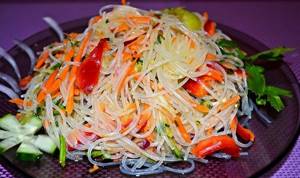
To prepare a snack, use Korean spicy carrots.
In Korean
This is another interesting option. Dressing for funchose in Korean will require even less effort and expense. For 150 g of noodles you will need 100 g of carrots, 150 g of fresh cucumbers, 50 g of sweet pepper, 15 g of garlic, 30 g of herbs.
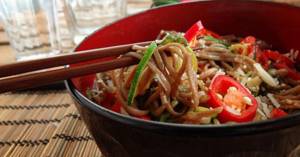
Funchoza is poured with boiling water for five minutes, placed in a colander and washed with boiled cold water. All vegetables (except herbs and garlic) are chopped into thin strips. Garlic and herbs are finely chopped. Rub the carrots with your hands until they release juice. All ingredients are mixed and infused in the cold for about two hours. Before serving, the Korean funchose dressing is thoroughly mixed again.
With mussels, mushrooms and zucchini
Seafood with funchose is an ideal combination. This dish is not only tasty, but also healthy.
- funchose – 50 g;
- soy sauce – 20 g;
- sesame – 1/2 tsp;
- pickled mushrooms (champignons or oyster mushrooms) – 150 g;
- zucchini – 400 g;
- mussels – 30 pcs.;
- Korean carrots – 50 g;
- butter – 20 g.
- Pour boiling water over the glass noodles. After 4-5 minutes, drain the water, rinse the vermicelli, and place in a colander.
- Wash and peel the zucchini. Cut the vegetables into cubes, fry in butter and sunflower oil for 5–7 minutes.
- Add yakitori sauce, sesame seeds, soy sauce, spices to taste (curry, red pepper, garlic). Simmer the ingredients until half cooked.
- Add pickled mushrooms, fry for 3 minutes. Add thawed mussels and simmer for another 3-5 minutes.
- Next, fry the carrots in Korean (3 minutes).
- Lastly, add funchose. Mix the contents of the pan thoroughly and simmer for 2-3 minutes. Serve the dish warm.

Be sure to defrost the mussels before frying.
Seasonings suitable for funchose
If you want to purchase a ready-made sauce for funchose, you will most likely have to choose between Chim-Chim and Sen Soy seasonings.
"Chim-Chim" contains:
- sunflower oil;
- sugar;
- salt;
- garlic;
- black pepper;
- coriander;
- red pepper;
- citric and acetic acids.
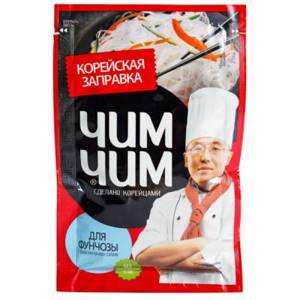
The manufacturer uses beneficial tocopherol as an antioxidant. To enhance the taste, he added monosodium glutamate to the dressing.
Sen Soy has a similar but not identical composition. It includes:
- water;
- sugar;
- Apple vinegar;
- sunflower oil;
- coriander;
- dried garlic;
- chilli.
Rosemary extract was used as an antioxidant, giving the seasoning additional flavor and aromatic notes. It couldn't be done without a flavor enhancer either. Contains the dressing and other components that do not pose a health hazard in moderate quantities. There is no salt in the seasoning. Perhaps the manufacturer wanted to give the cook the opportunity to season the salad with soy sauce, which is fully consistent with the traditions of Asian cuisine.
Having analyzed the composition of store-bought dressings, we can conclude that experts consider the following to be the most successful spices and herbs for funchose:
- coriander;
- garlic;
- hot red pepper;
- sugar;
- acetic or other acids;
- vegetable oil.
With shrimps and vegetables
An equally tasty dish is funchoza with vegetables and shrimp. The main components are as follows:
- funchose – 1 bunch;
- fresh cucumber – ½ piece;
- bell pepper – ½ piece;
- shrimp – 400 g;
- chili pepper – 1/3 tsp;
- olive oil – 1 tbsp. l.;
- carrots – 1 pc.
- olive oil – 1 tbsp. l.;
- liquid honey – 0.5 tsp;
- freshly squeezed lemon juice – 1 tsp;
- soy sauce – 1 tbsp. l.;
- lemon zest – 0.5 tsp;
- garlic – 1 clove.
- Thaw, peel, and wash the shrimp.
- Cut carrots and sweet peppers into thin strips.
- Fry in olive oil for 2 minutes.
- Add shrimp.
- Pour boiling water over funchoza. After 7 minutes, drain the water and place the noodles in a colander. Then place in a bowl, add fried shrimp and vegetables.
- Make the dressing: mix chopped lemon zest, garlic, olive oil, honey. Pour in lemon juice and soy sauce.
- Season the vermicelli, add chopped cucumber.
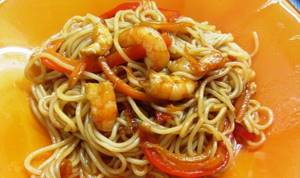
Pre-fry the shrimp with vegetables for the dish.
Dry seasoning for funchose
Compound:
- coriander – 10 g;
- black peppercorns – 5 g;
- dried chili pepper – 2 g;
- dried paprika – 8 g;
- garlic powder – 5 g;
- ginger powder – 5 g.
Cooking method:
- Pour coriander seeds and peppercorns into a coffee grinder and turn on the device for 15-20 seconds.
- Add pieces of hot pepper and paprika. Grind them together with coriander and black pepper, turning on the coffee grinder for another half a minute.
- Pour the ground spices into a jar, add dried and chopped ginger and garlic to them.
- Close the jar and shake until the ingredients are well mixed.
When using dry seasoning to prepare a salad for funchose, you also need to add sesame, corn or sunflower oil, vinegar or lemon juice, sugar or honey, soy sauce or salt. The choice of components and their ratio will depend on the gastronomic preferences of the cook and those for whom he prepares food.
Spicy salad
The dish is prepared according to a classic Asian recipe. To make the salad more refreshing, you can increase the amount of cucumber. The soy sauce used also affects the taste.
- funchose – 100 g;
- cucumber – 1 pc.;
- soy sauce – 1 tbsp. l.;
- Korean carrots – 100 g;
- garlic – 1 clove;
- olive oil – 3 tbsp. l.
- Boil the glass noodles until done.
- Chop the garlic into small pieces.
- Cut the cucumber into strips.
- Combine the components in one container.
- Add soy sauce and olive oil.
- If desired, garnish the salad with Asian-style fish fillet.
Recipe 5, simple: homemade dressing for funchose.
- soy sauce 8 tablespoons
- lemon juice 8 tablespoons
- ground dry ginger 4 tbsp
- curry seasoning 4 tbsp
- water 8 tbsp. spoons
Mix all of the above and cook for 2 minutes. The funchose sauce should be a little thick.
Then the cilantro needs to be washed and chopped. Add greens to the shrimp with vegetables, add boiled funchose, stir and let the salad with funchose noodles brew for about 1 hour.
With broccoli and salmon
You can also prepare funchose for dinner. Use broccoli and red fish as additional ingredients. The dish will turn out tasty and light, and it will take no more than 25 minutes.
- water – 200 ml;
- glass vermicelli – 100 g;
- salmon – 300 g;
- broccoli – 250 g;
- cream 15% fat – 200 ml;
- salt – 0.5 tsp.
- Divide the cabbage into florets. Place them in a bowl that can be placed in the oven.
- Spread the pasta on top.
- Remove the skin from the red fish. Cut it into medium sized pieces. Place the fillet on top of the funchose in an even layer.
- Add salt to taste.
- Add water and cream.
- Cover the container with a lid and place in an oven preheated to 180˚C. After 25 minutes the dish will be ready to eat.
With pork
The salad made from funchose and pork is tasty and satisfying. At the same time, the dish is not heavy on the stomach.
- glass noodles - 1 package;
- vegetable oil – 2–3 tbsp. l.;
- pork – 200 g;
- Korean dressing for noodles – 1 pack;
- Korean carrots – 200 g;
- bell pepper – 2 pcs.;
- onion – 1 pc.;
- cucumber – 1 pc.;
- soy sauce – 4 tbsp. l.
- Cut the onion into half rings. Fry it until golden brown.
- Add the meat cut into strips.
- Pour soy sauce over ingredients. Simmer them under a closed lid.
- Cut the cucumber and pepper into strips. Add to meat, mix thoroughly. Simmer until soft, then remove from the burner and cool slightly.
- Place the noodles in boiling water for 3 minutes. Then rinse and drain in a colander. Cut the funchose into pieces to make it easier to eat.
- Combine vermicelli with vegetables, meat and Korean carrots, after squeezing out the excess marinade.
How to cook “Vermicelli funchoza”
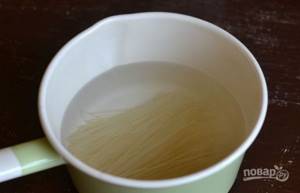
Boil water and pour it over the funchose. Cover the dish with a lid and let it sit for five to seven minutes. These noodles cook very quickly, so you don't even need to boil them.
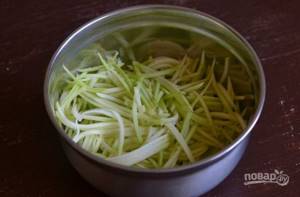
Wash the zucchini, pat dry with paper towels and trim the ends on both sides. Chop them on a Korean carrot grater so that you get long strips.
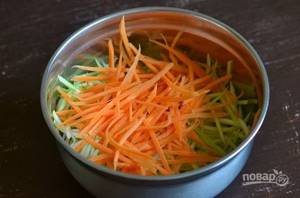
Peel and wash the carrots. Cut it into the same strips as zucchini. Place vegetables in a deep bowl.
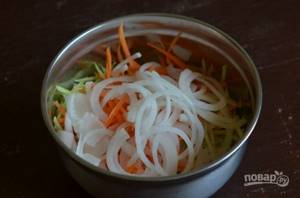
Peel the onion and wash it. Cut it into thin half rings. Then add the onions to the rest of the vegetables. You can use any onion, but it is better to use white or lettuce onions.
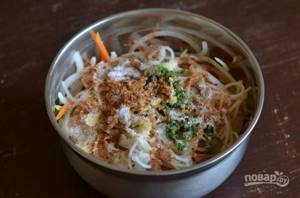
Drain the liquid from the funchose and add it to the bowl. Also add garlic and chopped herbs that have been pressed through a press. Pour in vinegar, vegetable oil, add salt, sugar and spices.
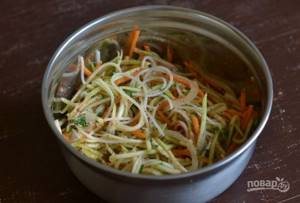
Mix all ingredients thoroughly and let them brew for an hour. Serve the noodles as an appetizer or instead of a salad.
Useful tips
Properly cooked funchose is the basis of many exotic dishes. There are some nuances in its preparation:
- Cook the pasta over high heat – it should be boiling hot.
- Prepare as many servings as you will eat at one time. When stored, the noodles stick together into an unappetizing lump. If everything is done correctly, the product will be transparent, with a slight grayish tint.
- Read the instructions on the package carefully. It indicates the time and method of cooking a specific type of vermicelli.
- Pour a spoonful of sunflower oil into the water - this will prevent the thin fibers from sticking together.
- For convenience, use a thread: tie it around the noodles and hold it by the free edge. Remove the finished product from boiling water and place it in cold water for 2-3 seconds. Then remove the thread. This way you will maintain the shape of the products and be able to decorate the dish beautifully.
- Rinse the finished noodles with running cold water. It’s better to prepare a container with ice in advance to immediately cool the funchose.
- If you need to chop fiber for a dish, do it after cooking. This way you will get components that are the same length. Dry vermicelli is brittle.
What is funchose and its beneficial properties
Funchose is made from bean and potato starch, as well as corn, rice flour, and yams. When dry, it has a transparent color, which is why it is popularly called “glass noodles,” but when cooked, it turns white and tastes like spaghetti.
The noodles also include:
- Squirrels.
- Minerals.
- Amino acids.
- Cellulose.
- Fatty acid.
All these beneficial properties provide the body with strength, energy, and have a positive effect on mental activity and the nervous system. Just like all legumes, noodles help remove toxins from the human blood.
Interesting fact: noodles do not have their own taste; they acquire their taste properties thanks to the products with which they are served.
Funchoza is such a universal product. It is added to first courses, second courses, salads and snacks.

